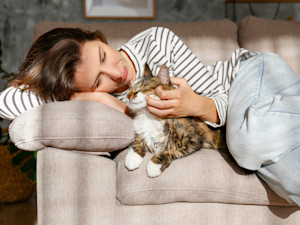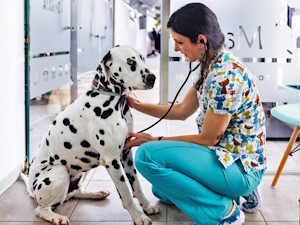Is Your Pet Better Off With You In The Exam Room at the Vet or Not?
Veterinarians weigh in on whether you should accompany your pet in the exam room—or let them fly solo.

Share Article
Whenever I bring my dog, Banshee, to see her vet, I’m faced with multiple anxieties. Sure, most revolve around cost, just as it does when I take myself to the human doctor and worry what insurance willopens in a new tab and won’t cover. But after mentally cataloging the worth of my vintage typewriter collection, I’m forced to focus on more immediate concerns.
You see, Banshee has a, er, complicated personality. She’s incredibly animal-reactiveopens in a new tab, making entering the veterinarian’s office a whole ordeal best executed through back or side doors. Unfortunately, that is but the beginning of our journey, because she’s also inherited my relentless anxiety. Her stress gets especially bad when I’m not there.

littleKin™ is Kinship’s home just for puppy and kitten parents. Bop over to check out expert advice, new pet tools, and special deals—all curated for your newest family member.
opens in a new tabThis can make the process of actually seeing the vet for their services even more difficult. If I don’t join her in the room while she has her exam, she’ll have a meltdown. But some vets we’ve been to insist on pets going into the room solo, which only raises both of our stress levels. Of course, the opposite scenario brings along its own issues.
While she’s not aggressive toward humans in the slightest, she’s a big girl and fears that she might protectively lash out often linger in the exam room. None of this will come as a surprise for pet parents in similar situations. Still, the dilemma of whether or not to accompany your pet while visiting the vet persists. So, what’s the best option? Well, it depends.
Option One: Let your dog take a solo trip
Veterinarian and founder of the Chagrin Falls Veterinary Center and Pet Clinicopens in a new tab Dr. Carol Osborne explains that prior to the pandemic it was normal for dog parents to join their pets in exam rooms during visits to her clinic. Then, thanks to social distancing demands, this shifted and humans were rarely allowed inside the rooms with their animals. It was an experience she describes as eye-opening, noting how seamless the process had become.
“Exams proceeded smoothly, pets were relaxed, and pet parents were pleased. Ultimately, the experiences were so successful we routinely discourage pet parents from joining their pets in the exam room,” she explains.
Under this new scenario, however, Dr. Osborne notes that it’s crucial vets chat extensively with pet parents prior to examinations. This strategy will allow them to detail the primary focus of the visit so nothing is missed or misunderstood. Not to mention, vets are then able to focus 100 percent on their patient during the actual checkup, with no lingering distractions or worries about the concerned parents.
Dr. Osborne now believes that having pet parents wait outside while the vet examines the pet in the exam room offers the "best, most successful, least stressful environment for all involved.”
And that includes the pets themselves. From the dog’s perspective, not having you in the room can help minimize their anxiety, since there won’t be anyone they feel they must protect from the spooky doctors. This may also help the vets get the information they need faster and easier (especially if they’re doing something they need your pet to stay still for, like a blood draw). According to Dr. Osborne, pet parents in the exam room can often be a distraction for both the animal and vet. She warns: “Their presence in 99 percent of cases, ends up with the opposite effect of their initial intention.”
While parents are rarely permitted in the room for surgeries, Dr. Osborne also recommends taking this approach to standard visits. She usually advises people to relax in the waiting room, which will also avoid jumping to worst-case scenario fears in the moment. “It gives pets the best overall experience as far as obtaining an accurate diagnosis and receiving appropriate treatment in the least stressful, most loving environment,” she says.
Option Two: Stay by your pet’s side
Dr. Fleur Jones, a veterinarian with the Veterinary Emergency Groupopens in a new tab in Clearwater, Florida, has the opposite advice, at least for more mild-mannered pets. She points to the additional comfort gained when accompanying your dog into the exam room instead of letting the imagination run wild.
“I’ve found, especially as a pet owner myself, that waiting in the waiting area leads to a lack of transparency, more confusion with your pet’s diagnosis and treatment recommendations, and less patience because you don’t know what is happening in ‘the back’ and questioning the level of care your pet received,” she says.
As someone who primarily deals with animals in emergency situationsopens in a new tab, Dr. Jones explains that this level of transparency helps build trust with pet parents. “We find this alleviates a lot of owner stress because when you rush to an emergency hospital and are worried about your pet, the last thing you want is for them to be taken away from you,” she says.
They’re also able to see firsthand every step of the process so that there is no misinterpretation about what is being done and why. Not to mention, it helps pet parents better understand costs when the bill is eventually given. “In general, owners are much more comfortable staying with their pets through each step instead of being in a waiting room, unsure of what is happening, and pets are much more comfortable with their owners close by,” she adds.
That being said, Dr. Jones agrees that the best option is occasionally sticking to the waiting room, especially for pets that might be overly protective or parents prone to their own anxieties. Still, she recommends that time spent apart should be minimal. “However, even in these scenarios, I think it is appropriate to have the owner step out for the exam, sample collecting, or treatments. But in the waiting periods between each step, your pet will be much more comfortable waiting with you,” Dr. Jones adds.
So, what the heck should I do?
The fact that both docs make compelling cases isn’t likely to quell the concerns of overly nervous and uneasy pet parents like me. The big question still remains: Do I helicopter parentopens in a new tab, or let my free bird fly high? Ultimately, it comes down to whatever makes you and your pup feel most comfortable. Past experiences should, naturally, also factor into the decision. If you’ve often had a bad time accompanying your pet in the exam room, maybe swallow your fears and let them try it solo next visit.
Dr. Osborne notes that this might even help minimize separation anxiety down the line as it’ll offer your pet additional self-assurance and boost their overall belief in themselves. “Pets, like human children, have to have enough confidence to realize they can exist and will be just fine without their parents being with them every minute of the day,” she explains.
On the other hand, staying in the waiting room shouldn’t give you or your pet a panic attack, so switch your game plan if you need to. Regardless, as Dr. Jones puts it, no one is better equipped to make this decision for your dog than you.
“It truly is a personal decision for every pet owner to make, considering your level of comfortability, as well as your pet’s temperament to decide what you want to be present for,” she says.

Sean Zucker
Sean Zucker is a writer whose work has been featured in Points In Case, The Daily Drunk, Posty, and WellWell. He has an adopted Pit Bull named Banshee whose work has been featured on the kitchen floor and whose behavioral issues rival his own.
Related articles
 opens in a new tab
opens in a new tabHow to Help an Anxious Dog
Easy ways to calm your pup’s nerves.
 opens in a new tab
opens in a new tabHow to Get a Head Start on Your Pet’s Health
Spot lumps, limps, and lethargy early on.
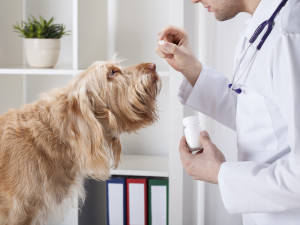 opens in a new tab
opens in a new tabHow to Find a Veterinary Specialist
Just like your doctor would refer to you a specialist for expert care for a complicated issue, your vet may do the same for your dog.
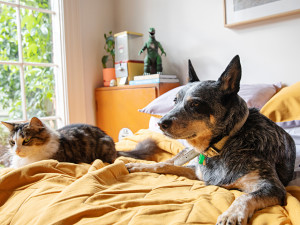 opens in a new tab
opens in a new tabWhat’s the Deal With Pet Insurance?
It covers your pet so you can get that broken leg fixed — while keeping your wallet happy.
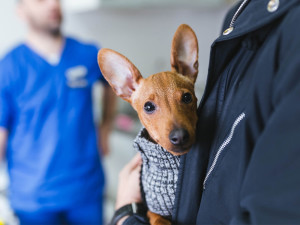 opens in a new tab
opens in a new tab8 Things Your Veterinarian Wishes You Wouldn’t Do
Common vet pet peeves, if you will.
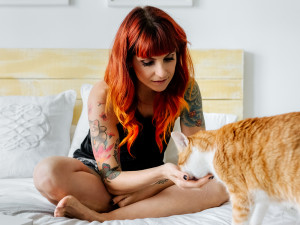 opens in a new tab
opens in a new tabDoes My Cat Really Need to See a Vet?
Cats can be hard to read. Especially when they’re sick. Or…not sick? We asked a veterinarian how to tell.

